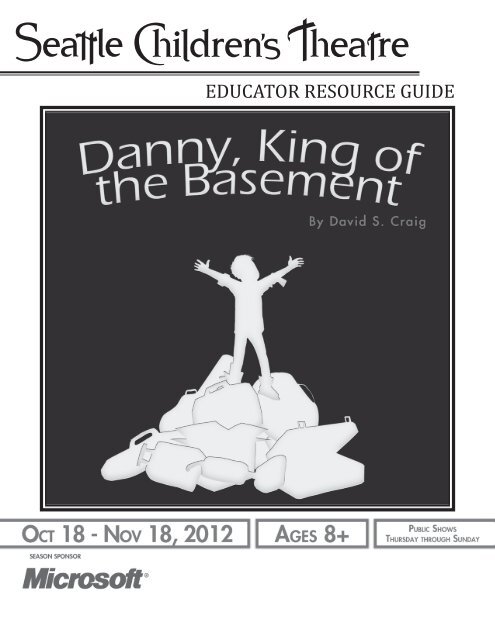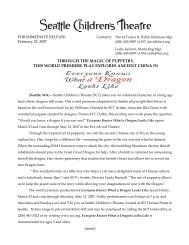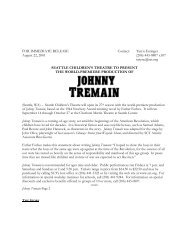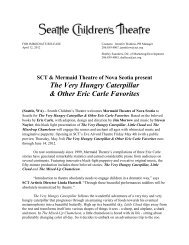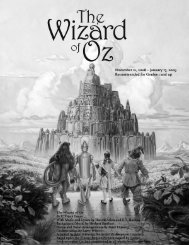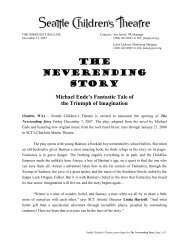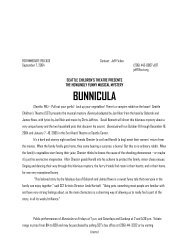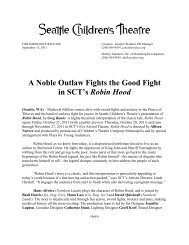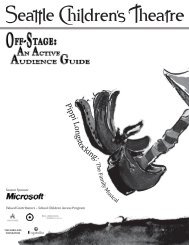Danny, King of the Basement - Seattle Children's Theatre
Danny, King of the Basement - Seattle Children's Theatre
Danny, King of the Basement - Seattle Children's Theatre
Create successful ePaper yourself
Turn your PDF publications into a flip-book with our unique Google optimized e-Paper software.
EDUCATOR RESOURCE GUIDE
Presents<br />
<strong>Danny</strong>, <strong>King</strong> <strong>of</strong><br />
<strong>the</strong> <strong>Basement</strong><br />
Table <strong>of</strong> Contents<br />
Synopsis .....................................................................................................................................................<br />
Curriculum Connections & EALRs ..................................................................................................<br />
David S. Craig, Playwright ....................................................................................................................<br />
A Chat with Chris Walker, Sound Designer ...................................................................................<br />
Make Some Theatrical Noise .............................................................................................................<br />
About <strong>the</strong> Set ..........................................................................................................................................<br />
About <strong>the</strong> Costumes ..............................................................................................................................<br />
No Place to Call Home ...........................................................................................................................<br />
<strong>Seattle</strong> Challenge and Urban Plunge .............................................................................................<br />
I Want to Help ..........................................................................................................................................<br />
Talk Yourself into It ................................................................................................................................<br />
Words & Phrases That Might Be New to You .............................................................................<br />
Activity Pages ..........................................................................................................................................<br />
Booklist ......................................................................................................................................................<br />
Evaluation Form .....................................................................................................................................<br />
2<br />
3-4<br />
5<br />
6-7<br />
8-9<br />
9<br />
10-11<br />
12-13<br />
14-15<br />
16-17<br />
18<br />
19<br />
20<br />
21-22<br />
23<br />
24
SYNOPSIS<br />
<strong>Danny</strong>’s mo<strong>the</strong>r, Louise, wakes him to tell him that her latest boyfriend didn’t turn out to be Prince<br />
Charming and <strong>the</strong>y are moving again. So <strong>the</strong>y head out, pushing a shopping cart and towing <strong>the</strong>ir<br />
tattered luggage. It’s <strong>the</strong>ir eighth move in two years because <strong>the</strong>y never have enough money to<br />
pay <strong>the</strong> rent. It’s cold but <strong>the</strong>y make it a long way across <strong>the</strong> city, with <strong>Danny</strong> navigating a number<br />
<strong>of</strong> bus routes to get <strong>the</strong>m to <strong>the</strong>ir new home, a basement apartment in a house on Clinton Street.<br />
<strong>Danny</strong> doesn’t mind moving. In fact, he’s good at it. He can pack quickly, knows <strong>the</strong> bus system,<br />
and he can “make a best friend in a day.” He gets to <strong>the</strong> apartment first. While he’s waiting on <strong>the</strong><br />
street for his mo<strong>the</strong>r to catch up, he passes <strong>the</strong> time assuming his imaginary<br />
secret agent identity, using a toy microphone to communicate with a master<br />
control station. When a neighbor boy, Angelo, comes along, <strong>Danny</strong> hides and<br />
watches as Angelo picks up <strong>the</strong> microphone and pretends to order a pizza.<br />
Angelo is a young hockey player who has never managed to score a goal<br />
and struggles for attention from his unemployed dad. Startled by <strong>Danny</strong>,<br />
Angelo quickly puts down <strong>the</strong> toy, but <strong>Danny</strong> encourages him to continue<br />
pretending. Louise arrives, Angelo goes home and it’s time for <strong>Danny</strong> and<br />
his mom to go into <strong>the</strong>ir new place.<br />
But <strong>Danny</strong> insists that Louise get <strong>the</strong>m some food before <strong>the</strong>y settle in. He<br />
gives her <strong>the</strong> last <strong>of</strong> <strong>the</strong>ir money—$6.98—and tells her exactly what she<br />
can afford to buy. He refuses to go into <strong>the</strong> basement apartment until she<br />
returns with <strong>the</strong>ir meager groceries.<br />
As he’s waiting for his mom, he spends some more time with Angelo and begins building a<br />
friendship with him. He also meets <strong>the</strong> house owner’s privileged daughter, Penelope. She<br />
demands he remove his belongings from <strong>the</strong> front <strong>of</strong> her private property, and refuses to believe<br />
<strong>Danny</strong> when he says he lives in <strong>the</strong> house, too. <strong>Danny</strong> goads her into betting her brand new coat<br />
on it and <strong>the</strong>n he reveals <strong>the</strong> key to <strong>the</strong> basement apartment. Penelope says she’ll do anything<br />
to get out <strong>of</strong> <strong>the</strong> bet. <strong>Danny</strong> asks her to swear on whatever is most important in her life. He also<br />
gives her an example <strong>of</strong> what he means; more than anything, <strong>Danny</strong> wants his fa<strong>the</strong>r, a firefighter<br />
in <strong>the</strong> Rocky Mountains, to live with him and his mom.<br />
Penelope feels a little uncomfortable sharing with<br />
this stranger, but says that she wants her separated<br />
parents to talk to each o<strong>the</strong>r so that she won’t be<br />
caught in <strong>the</strong> middle <strong>of</strong> <strong>the</strong>ir fights. <strong>Danny</strong> doesn’t<br />
take her coat. Instead, he asks only that she be nice to<br />
his friends—specifically, Angelo.<br />
Continued on <strong>the</strong> next page...<br />
3
Though Angelo and Penelope are neighbors, <strong>the</strong>y haven’t gotten along for years. But Penelope<br />
upholds her promise to act nice and <strong>Danny</strong>’s good games quickly bring <strong>the</strong> three kids toge<strong>the</strong>r.<br />
Anything is possible with a great imagination, and <strong>the</strong> three pretend to be pr<strong>of</strong>essional hockey<br />
players, secret agents and even a medical team operating on Angelo’s brain to improve his<br />
hockey skills. <strong>Danny</strong> believes he can solve anything with a game and he even ventures to talk to<br />
Angelo’s intimidating dad, who can <strong>of</strong>ten be heard up and down <strong>the</strong> street, yelling and growling<br />
like a dinosaur.<br />
<strong>Danny</strong>’s mo<strong>the</strong>r gets a job as a waitress, and <strong>Danny</strong>’s life seems okay. <strong>Danny</strong> still<br />
manages <strong>the</strong> money because o<strong>the</strong>rwise his mom spends it as soon as she gets it.<br />
But things are getting better.<br />
Until one day when Louise’s boss ends up in <strong>the</strong> hospital and she<br />
thinks she is going to lose her job. That same day <strong>Danny</strong> is called<br />
on to read aloud in school and his friends realize he can’t read. He<br />
flees in embarrassment. He’s ready to move again. He wants to be<br />
with his dad. But <strong>the</strong> biggest blow <strong>of</strong> all comes when he gets home.<br />
His mom hasn’t lost her job—in fact, she’s been promoted—but<br />
she finally admits she’s been lying about <strong>Danny</strong>’s fa<strong>the</strong>r. She has<br />
never had any idea where he is. <strong>Danny</strong> runs away to find his fa<strong>the</strong>r,<br />
certain that will solve his problems.<br />
Wandering <strong>the</strong> streets in <strong>the</strong> cold without proper clo<strong>the</strong>s, <strong>Danny</strong> is in serious danger. His mo<strong>the</strong>r<br />
and friends search for him desperately, and eventually find him in critical condition at <strong>the</strong><br />
hospital. It’s touch-and-go as <strong>the</strong> hospital staff revive <strong>Danny</strong>. At first <strong>Danny</strong> isn’t sure he wants to<br />
go on living until he realizes how much his mo<strong>the</strong>r needs him. When he finally agrees to see his<br />
friends again, he discovers how much <strong>the</strong>y missed him, too. Angelo shows him <strong>the</strong> puck, signed<br />
by his fa<strong>the</strong>r, from his first hockey goal. <strong>Danny</strong> realizes what’s most important: a true home with<br />
<strong>the</strong> love <strong>of</strong> his mo<strong>the</strong>r and good friends.<br />
4
CURRICULUM CONNECTIONS & EALRs<br />
<strong>Danny</strong>, <strong>King</strong> <strong>of</strong> <strong>the</strong> <strong>Basement</strong> touches on many <strong>the</strong>mes and ideas. Here are a few we believe would<br />
make good Curriculum Connections: Homelessness, Community, Employment, Materialism,<br />
Friendship, Parental Responsibility, Empathy, Resilience, Imagination, Literacy.<br />
We believe that seeing <strong>the</strong> show and using our Educator Resource Guide can help you meet <strong>the</strong><br />
following EALRs:<br />
<strong>Theatre</strong><br />
Reading<br />
Social Studies<br />
Communication<br />
State Standards<br />
1. The student understands and applies arts knowledge and skills.<br />
1.1 Understand arts concepts and vocabulary, specifically, identifies and describes<br />
characters, setting, actions, conflict, sounds.<br />
1.2 Develops <strong>the</strong>atre skills and techniques.<br />
1.3 Understands and applies <strong>the</strong>atre genres and styles <strong>of</strong> various artists, cultures, and times<br />
1.4 Understands and applies audience conventions in a variety <strong>of</strong> settings and<br />
performances <strong>of</strong> <strong>the</strong>atre.<br />
3. <strong>Theatre</strong>: The student communicates through <strong>the</strong> arts (dance, music, <strong>the</strong>atre, and visual arts).<br />
3.1 Uses <strong>the</strong>atre to express feelings and present ideas.<br />
3.2 Uses <strong>the</strong>atre to communicate for a specific purpose.<br />
1. The student understands and uses different skills and strategies to read.<br />
1.1 Use word recognition skills and strategies to read and comprehend text.<br />
1.2 Use vocabulary (word meaning) strategies to comprehend text.<br />
1.3 Build vocabulary through wide reading.<br />
1.4 Apply word recognition skills and strategies to read fluently.<br />
2. The student understands <strong>the</strong> meaning <strong>of</strong> what is read.<br />
2.1 Demonstrate evidence <strong>of</strong> reading comprehension.<br />
2.2 Understand and apply knowledge <strong>of</strong> text components to comprehend text.<br />
2.3 Expand comprehension by analyzing, interpreting, and syn<strong>the</strong>sizing information and<br />
ideas in literary and informational text.<br />
3. The student reads different materials for a variety <strong>of</strong> purposes.<br />
3.1 Read to learn new information.<br />
3.2 Read to perform a task.<br />
3.4 Read for literary experience in a variety <strong>of</strong> genres.<br />
2. ECONOMICS The student applies understanding <strong>of</strong> economic concepts and systems<br />
to analyze decision-making and <strong>the</strong> interactions between individuals, households,<br />
businesses, governments, and societies.<br />
2.1 Understands that people have to make choices between wants and needs and evaluate<br />
<strong>the</strong> outcomes <strong>of</strong> those choices.<br />
1. The student uses listening and observation skills and strategies to gain understanding.<br />
1.1 Uses listening and observation skills and strategies to focus attention and interpret<br />
information.<br />
1.2 Understands, analyzes, syn<strong>the</strong>sizes, or evaluates information from a variety <strong>of</strong> sources.<br />
5
DAVID S. CRAIG, PLAYWRIGHT<br />
<strong>Danny</strong>, <strong>King</strong> <strong>of</strong> <strong>the</strong> <strong>Basement</strong> has been performed all over<br />
Canada and <strong>the</strong> United States and in o<strong>the</strong>r parts <strong>of</strong> <strong>the</strong> world as<br />
well. This is an interview that playwright David S. Craig gave a<br />
middle-school student from Vienna, Austria about five years ago.<br />
When did you start writing plays?<br />
I was an actor and I wanted some good roles to perform in<br />
so I started writing plays. At first <strong>the</strong> plays were very simple.<br />
The first play I wrote was The Bearded Lady Loves <strong>the</strong> Mayor.<br />
I played <strong>the</strong> bearded lady! We performed it in parks and it<br />
involved a lot <strong>of</strong> running!<br />
Why do you write plays for children and not adults?<br />
Actually, I write plays for adults, too. But I am best known for my plays for children. I don’t know<br />
why that happened. I wrote one and it went well so I wrote ano<strong>the</strong>r and it went well and <strong>the</strong>n<br />
people started asking me to write plays so I did and <strong>the</strong>n I was a “Children’s Playwright.” I do<br />
love making kids laugh and trying to say complicated things in simple ways.<br />
How did you get inspired to write <strong>Danny</strong>, <strong>King</strong> <strong>of</strong> <strong>the</strong> <strong>Basement</strong>?<br />
I was driving in my car listening to <strong>the</strong> radio. The news was on and <strong>the</strong> announcer was talking<br />
about a report on homelessness in Toronto, where I live. Now I knew <strong>the</strong>re was a problem with<br />
homelessness (we’ve all seen that, right?) but I didn’t know that 25 percent <strong>of</strong> <strong>the</strong> people who<br />
are homeless are children under <strong>the</strong> age <strong>of</strong> 12. That really, really surprised and saddened me<br />
because Toronto is <strong>the</strong> richest city in Canada and probably one <strong>of</strong> <strong>the</strong> richest cities in <strong>the</strong> world. I<br />
decided, right <strong>the</strong>n, that I had to do something—as a fa<strong>the</strong>r and a citizen and a playwright—and<br />
what I decided to do was write a play.<br />
Why do you think your play is so successful?<br />
I don’t know. I think it’s a miracle. None <strong>of</strong> my o<strong>the</strong>r plays have been understood so well and<br />
so quickly. People say <strong>the</strong> story is universal, but as you can see from what I wrote above, <strong>the</strong><br />
motivation for <strong>the</strong> play was very personal and very local.<br />
Which <strong>of</strong> <strong>the</strong> parents we see on stage (<strong>Danny</strong>’s mo<strong>the</strong>r, Penelope’s mo<strong>the</strong>r or Angelo’s<br />
fa<strong>the</strong>r) would you choose if you were a child and had to choose?<br />
That is a very interesting question. I think I would choose <strong>Danny</strong>’s mo<strong>the</strong>r because she seems<br />
like a lot <strong>of</strong> fun. But my own parents made sure I had warm clo<strong>the</strong>s, lots to eat and took me<br />
skiing which I loved. <strong>Danny</strong>’s mo<strong>the</strong>r couldn’t afford those things.<br />
Continued on <strong>the</strong> next page...<br />
6
We don’t know what memories <strong>Danny</strong> has <strong>of</strong> his fa<strong>the</strong>r or if he has memories at all. What is<br />
your opinion?<br />
I think <strong>Danny</strong>’s fa<strong>the</strong>r left shortly after <strong>Danny</strong> was born. I think he never intended to be a fa<strong>the</strong>r<br />
and so one day he just left. This meant Louise had to raise <strong>Danny</strong> on her own. When <strong>Danny</strong><br />
started getting older and began asking questions about his dad, Louise made up a story <strong>of</strong> how<br />
his dad was away being a fire-fighter in <strong>the</strong> Rocky Mountains. She even sent <strong>Danny</strong> a postcard<br />
<strong>of</strong> <strong>the</strong> Mountains as if it came from his dad. The postcard became <strong>Danny</strong>’s most treasured<br />
possession.<br />
When you were a boy, what were your dreams? Did you dream <strong>of</strong> working in <strong>the</strong> <strong>the</strong>ater?<br />
When I was a boy I sang in a church choir and I dreamed <strong>of</strong> being a Vienna Choir Boy. It’s true. I<br />
had seen a Walt Disney movie about <strong>the</strong>m and I wanted to learn German and move to Austria. I<br />
asked my choir master how long it would take to learn German and he said a long time. No one<br />
encouraged my dream so I eventually believed it was impossible. Sigh.<br />
What do you like most about your kind <strong>of</strong> work?<br />
Working with o<strong>the</strong>r artists and <strong>the</strong>ater pr<strong>of</strong>essionals. I love being part <strong>of</strong> a team. Instead <strong>of</strong><br />
winning a game, we work toge<strong>the</strong>r to put on a show. I love putting on shows.<br />
David S. Craig has written more than 20 pr<strong>of</strong>essionally produced plays including <strong>the</strong> international<br />
hit comedy Having Hope at Home. His adaptation <strong>of</strong> The Neverending Story premiered at <strong>the</strong><br />
Imagination Stage and <strong>the</strong> <strong>Seattle</strong> Children’s <strong>Theatre</strong> and recently played to rave reviews at Young<br />
People’s <strong>Theatre</strong> in Toronto and <strong>the</strong> Skirball Center in New York. For Roseneath <strong>Theatre</strong> he has<br />
written <strong>the</strong> internationally acclaimed <strong>Danny</strong>, <strong>King</strong> <strong>of</strong> <strong>the</strong> <strong>Basement</strong> (Dora Mavor Moore Award for<br />
Best Production, German Children’s <strong>Theatre</strong> Prize nomination) as well<br />
as Tough Case, Smokescreen and Rocket and <strong>the</strong> Queen <strong>of</strong> Dreams.<br />
With Robert Morgan he has written Morgan’s Journey, Head à Tête, The<br />
Book <strong>of</strong> Miracles, Health Class and Dib and Dob and <strong>the</strong> Journey Home.<br />
His one-man show Napalm <strong>the</strong> Magnificent was performed extensively<br />
in Canada and at <strong>the</strong> John Houseman <strong>Theatre</strong> Centre on <strong>Theatre</strong> Row<br />
in Manhattan. His plays have received <strong>the</strong> Chalmers Award twice and<br />
<strong>the</strong> Dora Award for Outstanding Production four times. For CBC Radio,<br />
David created a fifty-one part series for Morningside based on his stage<br />
play Booster Crane, P.M. and for Metro Morning he created a 50-episode<br />
series titled The Diamond Lane. NOW magazine has called David S.<br />
Craig, “one <strong>of</strong> <strong>the</strong> top twenty playwrights in Canada.”<br />
7
A CHAT WITH CHRIS WALKER, SOUND DESIGNER<br />
Please tell us a little bit about your working process.<br />
My job as a sound designer is to put toge<strong>the</strong>r all <strong>the</strong> sound<br />
elements for a play. That means I write and record <strong>the</strong> music<br />
and create <strong>the</strong> sound effects you hear.<br />
When I first read a play, I’m not really trying to figure out what<br />
it sounds like—not right away. Of course what I’m eventually<br />
going to have in my head is <strong>the</strong> combination <strong>of</strong> environmental<br />
sounds (street noises, wind, rasping sand on stone) and<br />
music—but not right away. At first I just want to know what <strong>the</strong><br />
show feels like, how it hits me emotionally. After reading it a<br />
couple times maybe <strong>the</strong>n I’ll have an idea <strong>of</strong> <strong>the</strong> sound, and after<br />
I talk with <strong>the</strong> director, <strong>the</strong>n I’ll REALLY know a lot more and I’ll start to put toge<strong>the</strong>r a rough<br />
demo <strong>of</strong> <strong>the</strong> score (<strong>the</strong> music for <strong>the</strong> play).<br />
But hands down <strong>the</strong> most important thing for me is listening to <strong>the</strong> actors say <strong>the</strong> words. For<br />
me <strong>the</strong>re is nothing more useful than <strong>the</strong> first read-through <strong>of</strong> <strong>the</strong> play. Once I hear <strong>the</strong> sound <strong>of</strong><br />
<strong>the</strong> words coming out <strong>of</strong> <strong>the</strong> actors’ mouths, <strong>the</strong>n, and only <strong>the</strong>n really, do I fully know what <strong>the</strong><br />
show is going to sound like. How <strong>the</strong> music <strong>of</strong> <strong>the</strong>ir voices is going to combine with my sounds<br />
and music…<strong>the</strong>n I know <strong>the</strong> feel that we’ll bring to <strong>the</strong> stage toge<strong>the</strong>r.<br />
What is a particularly interesting or unusual challenge on this project, and how are you<br />
setting out to solve it?<br />
On this project I think <strong>the</strong> most interesting thing is <strong>the</strong> conflict between <strong>the</strong> real world and<br />
<strong>the</strong> fantasy worlds that <strong>the</strong> characters get caught up in. The tricky thing is not to wallow in <strong>the</strong><br />
grim part <strong>of</strong> real life…I tend to go <strong>the</strong>re easily. But in this play <strong>the</strong>re’s a lot <strong>of</strong> happiness, love,<br />
excitement and energy. My job is to help bring that out with <strong>the</strong> sound and music.<br />
Currently I’m planning on having almost two separate kinds <strong>of</strong> scores. Different instrumentation<br />
will help that: for instance, maybe when we’re in real life it’s only one instrument playing <strong>the</strong><br />
music, like a piano. And <strong>the</strong>n when we’re in <strong>the</strong> various fantasy worlds perhaps we’re using a<br />
full orchestra for music, or at least a small band—something that’s a difference from <strong>the</strong> solo<br />
instrument <strong>of</strong> <strong>the</strong> “real” world. At least that’s what I’m thinking right now.<br />
What in your childhood got you to where you are today?<br />
My Dad played <strong>the</strong> piano, my Mom played <strong>the</strong> piano and <strong>the</strong> violin. They were musical and<br />
<strong>the</strong>y wanted me to be musical, so <strong>the</strong>y started me on piano lessons at age seven. I took to it big<br />
time. At nine I started playing clarinet, and at ten, guitar. I loved all <strong>of</strong> it. Oh, and I also started<br />
composing almost immediately, really from age seven on.<br />
Continued on <strong>the</strong> next page...<br />
8
In high school people started commenting to me that <strong>the</strong> music I composed would remind <strong>the</strong>m<br />
<strong>of</strong> things. They’d say “Oh, you must have been thinking about this when you composed that<br />
piece.” They never got it right, because I was never particularly thinking about any one thing, but<br />
I realized <strong>the</strong> music I made put pictures in people’s minds. So I figured I should go with that—I<br />
should make music for visuals. Film, <strong>the</strong>ater, dance—that’s what I’m good at scoring.<br />
I decided to go to an arts college (Cornish), and majored in Classical Piano Performance. Once<br />
<strong>the</strong>re I started composing music for <strong>the</strong> <strong>the</strong>ater department, and over <strong>the</strong> next four years I<br />
started designing more and more shows outside <strong>of</strong> college. By <strong>the</strong> time I graduated, I had enough<br />
<strong>of</strong> a reputation that I was able to move right into a job running sound and scoring shows for <strong>the</strong><br />
Intiman <strong>Theatre</strong>. And that began my pr<strong>of</strong>essional career.<br />
Chris R. Walker is returning for his eleventh season as resident sound designer at SCT. In <strong>Seattle</strong>, he<br />
has designed at <strong>Seattle</strong> Rep, ACT, <strong>the</strong> 5th Avenue <strong>Theatre</strong> and Intiman. Nationally, he’s designed in<br />
San Francisco, Los Angeles, San Diego, Houston, Boston, Chicago and New York. Chris holds a BFA in<br />
Classical Piano Performance from Cornish College.<br />
MAKE SOME THEATRICAL NOISE<br />
How does <strong>the</strong> sound <strong>of</strong> each <strong>of</strong> <strong>the</strong>se instruments make you feel?<br />
Trumpet<br />
Big drum<br />
Violin<br />
Kazoo<br />
Piano<br />
Bell<br />
Which instrument would you use most if you were writing music for a:<br />
Bus ride<br />
Hospital visit<br />
Boring phone conversation<br />
Raccoon attack<br />
Hockey game<br />
Dream<br />
Class at school<br />
Snowstorm<br />
Pick your favorite <strong>of</strong> those actions and decide what non-musical sound effects you would add to<br />
your music to complete your score. What o<strong>the</strong>r instruments would you add?<br />
Using just your voice and body, act out <strong>the</strong> sound and <strong>the</strong> music you imagine.<br />
9
ABOUT THE SET<br />
From Carol Wolfe Clay, Set Designer<br />
Even though this play is called <strong>Danny</strong>, <strong>King</strong> <strong>of</strong> <strong>the</strong> <strong>Basement</strong>, we never actually go inside <strong>the</strong><br />
basement. The play takes place mostly outside, where <strong>Danny</strong> is most comfortable. But his<br />
basement home is a very real and very big part <strong>of</strong> <strong>the</strong> play. So, for me, <strong>the</strong> design challenge was<br />
to create a three-dimensional and real-looking group <strong>of</strong> homes on stage, but at <strong>the</strong> same time<br />
leave lots <strong>of</strong> open space where <strong>Danny</strong> and Penelope and Angelo could imagine and <strong>the</strong> story<br />
could be told.<br />
I started by looking at pictures <strong>of</strong> city neighborhoods and pictures <strong>of</strong> streetcars, wet streets<br />
and concrete for inspiration. I wanted <strong>the</strong> floor and <strong>the</strong> sky to look painterly, like a canvas for<br />
<strong>Danny</strong>’s imagination, and I wanted <strong>the</strong> group <strong>of</strong> homes to look solid and strong but also a bit<br />
mysterious. Rita Giomi, <strong>the</strong> director, wanted to make sure that it was clearly a place in a city, not<br />
in <strong>the</strong> country, and that it looked familiar, like it could be one <strong>of</strong> our own neighborhoods. We<br />
chose brick for <strong>the</strong> buildings, concrete steps and metal railings to help with this.<br />
Picture <strong>of</strong> homes on Clinton Street in Toronto,<br />
which inspired some aspects <strong>of</strong> <strong>the</strong> set design<br />
This picture <strong>of</strong> a streetcar on a wet city street provided a number <strong>of</strong> design ideas,<br />
including adding shiny patches to <strong>the</strong> floor<br />
Concrete pattern that influenced some <strong>of</strong><br />
<strong>the</strong> floor design<br />
Continued on <strong>the</strong> next page...<br />
10
Model <strong>of</strong> <strong>the</strong> set<br />
It was a challenge to create three<br />
complete homes on stage in such a<br />
small space. If you look, you’ll notice<br />
<strong>the</strong>re isn’t much room around <strong>the</strong><br />
windows and doors. I played with<br />
height changes to help define <strong>the</strong><br />
spaces. I added a tiny window in<br />
<strong>Danny</strong>’s apartment as mentioned in<br />
<strong>the</strong> script, gave Penelope’s window<br />
more <strong>of</strong> a formal look with black<br />
lacquered details and made sure to<br />
give Angelo’s house a big window<br />
so we could see his “dino dad.” I<br />
used some real and some painted<br />
architectural detail in order to pack<br />
a lot into a little space and to keep a<br />
balance between <strong>the</strong> realness <strong>of</strong> <strong>the</strong><br />
buildings and <strong>the</strong> imaginative painted<br />
sky and floor.<br />
It was fun to design <strong>the</strong> houses as<br />
such a close little group with multiple<br />
ro<strong>of</strong>lines and angles and varied<br />
architecture. It was even more fun to<br />
paint <strong>the</strong> colorful concrete floor and<br />
<strong>the</strong> sky with a shadowy city skyline!<br />
Technical drawing <strong>of</strong> Penelope’s house showing where three-dimensional<br />
bricks and trim will be added to <strong>the</strong> painted ones<br />
11
ABOUT THE COSTUMES<br />
From Rose Pederson, Costume Designer<br />
One <strong>of</strong> <strong>the</strong> things that is important in this play is <strong>the</strong> different finances <strong>of</strong> each <strong>of</strong> <strong>the</strong> families.<br />
This is very challenging to show with costumes because kids from different backgrounds tend<br />
to wear clo<strong>the</strong>s that all look very much alike.<br />
I looked through many magazines, searched <strong>the</strong> Internet for photos <strong>of</strong> children who are<br />
experiencing homelessness and visited schools to see what people were wearing, trying to find<br />
unique elements.<br />
Sketch <strong>of</strong> <strong>Danny</strong>’s first<br />
costume<br />
<strong>Danny</strong>’s second costume. The<br />
actors change costumes several<br />
times during <strong>the</strong> play to help us<br />
understand <strong>the</strong> passage <strong>of</strong> time.<br />
Angelo’s first costume shows<br />
what he wears home from<br />
hockey practice<br />
Angelo’s second costume<br />
It seemed a good idea to choose <strong>Danny</strong>’s clo<strong>the</strong>s from a thrift store, since that’s where he<br />
would get <strong>the</strong>m and <strong>the</strong>y would be less current. Also his clo<strong>the</strong>s are a little big to show he<br />
doesn’t have <strong>the</strong> option to get anything he wants and that his Mom is not necessarily paying<br />
enough attention to him.<br />
Angelo’s family has more money and more current clo<strong>the</strong>s, so he has <strong>the</strong> choice to wear sports<br />
gear and clo<strong>the</strong>s depicting his favorite sports team.<br />
Continued on <strong>the</strong> next page...<br />
12
Penelope gets <strong>the</strong> most <strong>of</strong> what she wants. She has more clo<strong>the</strong>s and newer popular clo<strong>the</strong>s,<br />
along with a fresh expensive haircut from a salon.<br />
Penelope’s second costume<br />
Sketch <strong>of</strong> Penelope’s first costume.<br />
She will be wearing her new coat<br />
over this dress.<br />
The greatest thing is that <strong>Danny</strong>’s clo<strong>the</strong>s may be <strong>the</strong> least<br />
interesting, but with his imagination he turns even his very<br />
plain jacket into something magical.<br />
One <strong>of</strong> <strong>the</strong> most exciting challenges was finding a way to<br />
costume Penelope’s mo<strong>the</strong>r in a way that would keep her as<br />
mysterious and invisible as <strong>Danny</strong>’s and Angelo’s fa<strong>the</strong>rs. So<br />
<strong>the</strong> director and I researched images <strong>of</strong> women in clo<strong>the</strong>s<br />
that almost swallowed <strong>the</strong>m up.<br />
When I dress, I want to make sure I am wearing <strong>the</strong> clo<strong>the</strong>s<br />
and <strong>the</strong> clo<strong>the</strong>s are not wearing me. In Penelope’s mo<strong>the</strong>r’s case<br />
Penelope’s mo<strong>the</strong>r is hidden by <strong>the</strong><br />
clo<strong>the</strong>s she wears<br />
we wanted her to be unreachable, so we wanted her clo<strong>the</strong>s to take over, make her almost<br />
a non-person, so busy in herself that we don’t actually see her—<strong>the</strong> same way she doesn’t<br />
really see Penelope.<br />
13
NO PLACE TO CALL HOME<br />
When people hear <strong>the</strong> word “homeless,” most still think <strong>of</strong> <strong>the</strong> more visible faces <strong>of</strong><br />
homelessness—people standing at highway on-ramps, or those who sleep under bridges<br />
or on park benches. A homeless person is legally defined as an individual who lacks a fixed,<br />
regular and adequate night-time residence or a person who resides in a shelter, welfare hotel,<br />
transitional program or place not ordinarily used as regular sleeping accommodations. The<br />
U.S. Department <strong>of</strong> Education’s definition includes children and youths “who are sharing <strong>the</strong><br />
housing <strong>of</strong> o<strong>the</strong>r persons due to loss <strong>of</strong> housing, economic hardship, or similar reason.” Families<br />
with children represent nearly half <strong>of</strong> <strong>the</strong> homeless people in Washington state. These are <strong>the</strong><br />
invisible faces <strong>of</strong> homelessness: parents and children “doubling up” with family or friends, living<br />
out <strong>of</strong> <strong>the</strong>ir cars or in motel rooms, or moving in and out <strong>of</strong> shelters.<br />
Homeless families with children struggle to navigate a complex web <strong>of</strong> support and service<br />
providers to get help and access to stable housing. If a family becomes homeless in Washington<br />
state, <strong>the</strong>y must look for help by contacting many different service agencies for different kinds <strong>of</strong><br />
assistance. Since few services are coordinated, it is hard for families to even know what kind <strong>of</strong><br />
help is available, and harder to get into a permanent home. During <strong>the</strong> 2009–2010 school year,<br />
<strong>the</strong> Office <strong>of</strong> <strong>the</strong> Superintendent <strong>of</strong> Public Instruction identified nearly 22,000 homeless children<br />
attending public schools in Washington state.<br />
Families become homeless for many reasons. Today’s weak economy means that more families<br />
experience unemployment, lower incomes, and housing foreclosures. O<strong>the</strong>r factors—such as<br />
domestic violence, medical crises, and mental health or addiction issues—also make families<br />
vulnerable.<br />
Continued on <strong>the</strong> next page...<br />
14
Whatever <strong>the</strong> cause, homelessness has a pr<strong>of</strong>ound impact on a child’s health and education. The<br />
constant movement and disruption associated with homelessness means that too many children<br />
are forced to move from school to school. National Alliance to End Homelessness research<br />
reveals that pr<strong>of</strong>iciency rates for homeless children in reading and math are, on average, 16<br />
percent lower than <strong>the</strong> scores for all students. Homeless children have twice as many learning<br />
disabilities and three times as many emotional and behavioral problems as children who are not<br />
homeless. Half <strong>of</strong> school-age homeless children experience anxiety, depression, or withdrawal.<br />
Fewer than one homeless child in four graduates from high school.<br />
Preventing and ending family homelessness will take <strong>the</strong> continued commitment <strong>of</strong> partners in<br />
government, nonpr<strong>of</strong>its, advocates, <strong>the</strong> private sector and people in families that are recovering<br />
from homelessness. It won’t be easy. But our communities will be stronger when we break <strong>the</strong><br />
cycle <strong>of</strong> poverty and crisis that can lead to family homelessness across generations.<br />
Excerpted and used by permission <strong>of</strong> <strong>the</strong> Gates Foundation<br />
http://www.gatesfoundation.org/topics/Pages/housing-homelessness.aspx<br />
TO GET HELP CONTACT:<br />
Washington Information Network 2-1-1<br />
An integrated system for people to call for health<br />
and human service information and referrals and<br />
o<strong>the</strong>r assistance to meet <strong>the</strong>ir needs.<br />
Call: 2-1-1<br />
or 206-461-3200<br />
800-621-4636 Toll Free<br />
206-461-3610 TDD<br />
Or search <strong>the</strong> website for resources at<br />
http://www.resourcehouse.info/WIN211<br />
<strong>King</strong> County 24-Hour Crisis Line:<br />
1-866-4CRISIS (1-866-427-4747)<br />
15
SEATTLE CHALLENGE AND URBAN PLUNGE: EXPERIENTIAL<br />
AND SERVICE LEARNING ABOUT URBAN POVERTY<br />
DANNY: How would you know, Penny? How would you know what it’s like to be me?<br />
You don’t know anything.<br />
–from, <strong>Danny</strong>, <strong>King</strong> <strong>of</strong> <strong>the</strong> <strong>Basement</strong> by David S. Craig<br />
Every spring, 8th graders at <strong>Seattle</strong> Academy <strong>of</strong> Arts and Sciences (SAAS) go through an<br />
experience called <strong>the</strong> <strong>Seattle</strong> Challenge. For three days <strong>the</strong>y walk through <strong>the</strong> city, visit agencies<br />
and organizations that provide help to people who may be without money, food, or a place to<br />
stay, and work for local social service agencies. They are asked to feed <strong>the</strong>mselves for a day on a<br />
two-dollar budget. At night, <strong>the</strong>y sleep in simulated shelters.<br />
The program allows students to experience some <strong>of</strong> <strong>the</strong> feelings <strong>of</strong> frustration and discomfort<br />
that many members <strong>of</strong> our urban community cope with on a regular basis. They also learn about<br />
<strong>the</strong> resources available to help people.<br />
At <strong>the</strong> end <strong>of</strong> <strong>the</strong> Challenge, students attend a debriefing session designed to help <strong>the</strong>m process<br />
<strong>the</strong>ir experiences. When <strong>the</strong>y are asked to express what <strong>the</strong>y felt <strong>the</strong>y learned during <strong>the</strong> threeday<br />
trip, some common <strong>the</strong>mes emerge:<br />
• They widen and change <strong>the</strong>ir ideas about who might be without a home and what it means<br />
to be homeless.<br />
• They learn that life can go on and <strong>the</strong>y can learn a lot simply by not always being around a<br />
familiar social group <strong>of</strong> family and friends.<br />
• On <strong>the</strong> o<strong>the</strong>r hand, <strong>the</strong>y also gain a new and increased appreciation <strong>of</strong> <strong>the</strong> life <strong>the</strong>y have,<br />
learning especially to value <strong>the</strong>ir education and relationships.<br />
• They learn that privacy is a gift, which people with no home do not have, whe<strong>the</strong>r in<br />
shelters or on <strong>the</strong> streets.<br />
• They feel pride in knowing that <strong>the</strong>y can endure without <strong>the</strong> usual comforts <strong>of</strong> life.<br />
• They gain a new feeling <strong>of</strong> independence through <strong>the</strong> knowledge <strong>the</strong>y could do hard<br />
physical work.<br />
One SAAS 8th grader said, “I will never look at <strong>the</strong> streets <strong>of</strong> <strong>Seattle</strong> <strong>the</strong> same way again.”<br />
Continued on <strong>the</strong> next page...<br />
16
SAAS modeled <strong>the</strong> <strong>Seattle</strong> Challenge after a program called Urban Plunge that <strong>Seattle</strong> Pacific<br />
University (SPU) has been running for many years. Urban Plunge, a five-day immersion<br />
experience that takes place during Christmas and Spring Breaks, is designed to give SPU<br />
students a taste <strong>of</strong> what it is like to live without a home and what resources are available to<br />
people in <strong>Seattle</strong> who do not have one. Nights are spent sleeping in a downtown church. During<br />
<strong>the</strong> day participants walk <strong>the</strong> streets, learn from representatives <strong>of</strong> local social service agencies,<br />
and experience some <strong>of</strong> <strong>the</strong> challenges that homelessness brings.<br />
According to Scott Jackson, director <strong>of</strong> <strong>the</strong> Urban Plunge program:<br />
The goal <strong>of</strong> Urban Plunge is to give students a personal experience that will equip <strong>the</strong>m to<br />
engage <strong>the</strong> homeless population with empathy and compassion. We hope that students will<br />
leave with a better understanding <strong>of</strong> homelessness and its myriad <strong>of</strong> causes. We encourage<br />
students to enter <strong>the</strong> experience humbly; students are not seeking an “extreme experience”;<br />
ra<strong>the</strong>r, <strong>the</strong>y seek to understand ano<strong>the</strong>r individual’s perspective. It is also our hope that<br />
students will also gain <strong>the</strong> knowledge and resources to get involved and serve in our local<br />
community.<br />
Of course, programs like Urban Plunge do not mean that participants have experienced<br />
homelessness. As one participant in an Urban Plunge put it, “Urban plunging to experience<br />
homelessness is like shoveling a sidewalk to experience Eskimo. No one becomes homeless<br />
because <strong>the</strong>y have something to gain from <strong>the</strong> experience.” Scott Jackson agrees:<br />
We stress at <strong>the</strong> end <strong>of</strong> Plunge that we have no right to say, “I lived on <strong>the</strong> street for 5 days;<br />
I know what it’s like!” Urban Plunge is only a small glimpse <strong>of</strong> what certain aspects <strong>of</strong><br />
homelessness are like, for instance, having no money, having to find your own food, and being<br />
ignored by mainstream society. The goal <strong>of</strong> Urban Plunge is to help students develop empathy<br />
and compassion. We hope our students will never know what it’s like to be homeless, but also<br />
that <strong>the</strong>y will have a better understanding <strong>of</strong> what this experience is like for o<strong>the</strong>rs.<br />
17
I WANT TO HELP<br />
You don’t have to be rich to help someone who has no home. Think about all <strong>of</strong> <strong>the</strong> things that you<br />
need during <strong>the</strong> day, and all <strong>the</strong> things you like to do. Kids who may not have a home right now<br />
need and like those things, too. All you need is permission from a parent or teacher to get started:<br />
• Look through your closet for clo<strong>the</strong>s that you don’t wear anymore. Shelters provide<br />
temporary places for people to stay and welcome most donations. Make sure <strong>the</strong> clo<strong>the</strong>s are<br />
clean and in good condition before you donate <strong>the</strong>m.<br />
• There are many o<strong>the</strong>r things you can collect from family and friends to donate to a shelter:<br />
o toys, games and sports equipment<br />
o gently used books<br />
o unused shampoo and soap—sample-size ones are good, too<br />
o good used coats are always needed<br />
• Think <strong>of</strong> something you like to do or have a special talent for that you can use to earn some<br />
money. If you like to cook, have a bake sale and give <strong>the</strong> money to a shelter. Maybe you<br />
and your friends could put on a talent show in your neighborhood, or <strong>of</strong>fer to walk your<br />
neighbors’ dogs to make some money to donate.<br />
• Ask your parents to help you plan and serve a meal at a shelter. Sometimes you can do<br />
something as simple as make sandwiches to take <strong>the</strong> people living <strong>the</strong>re. Check with <strong>the</strong><br />
shelter first to see what <strong>the</strong>y need.<br />
• For your next birthday party, instead <strong>of</strong> asking for presents, pick something you’d like<br />
everyone to bring that you can donate to o<strong>the</strong>r kids, or ask your friends and family to bring<br />
canned food that you can give to your local food bank.<br />
• See if your class or school can organize a penny drive to raise money for a shelter, a canned<br />
food drive to help keep <strong>the</strong> food banks filled, or collect school supplies for kids who need<br />
<strong>the</strong>m.<br />
These are two places that would be happy to have you volunteer your time:<br />
• Food Lifeline is a local organization that feeds hungry people. They have opportunities for<br />
volunteers age 5 and up. http://www.foodlifeline.org/help/index.html<br />
• Habitat for Humanity builds houses for and with families who need <strong>the</strong>m. You have to be 16<br />
to do any building, but <strong>the</strong>y have o<strong>the</strong>r ways for kids from 5 and up to help.<br />
http://www.habitat.org/youthprograms/<br />
But <strong>the</strong> most important thing you can do to help is to<br />
be kind to o<strong>the</strong>r kids. You can’t tell just by looking at<br />
someone whe<strong>the</strong>r or not <strong>the</strong>y have a home and you never<br />
know what someone else’s life is like. No matter what<br />
<strong>the</strong>y might be struggling with privately, <strong>the</strong>y are still kids<br />
and need <strong>the</strong> same things all kids need—friends, a safe<br />
place to play and learn, encouragement, fun and respect.<br />
Treat everyone <strong>the</strong> way you would like to be treated.<br />
18
TALK YOURSELF INTO IT<br />
In <strong>Danny</strong>, <strong>King</strong> <strong>of</strong> <strong>the</strong> <strong>Basement</strong>, Angelo feels like a loser because he has a hard time scoring goals<br />
in hockey. <strong>Danny</strong> asks him why he can’t score.<br />
ANGELO: Sometimes when I get a breakaway I go to shoot and <strong>the</strong>n this thought<br />
comes into my head that says “You’re going to blow it, you’re going to blow it”<br />
and I blow it.<br />
PENELOPE: That’s a brain freeze.<br />
Penelope has <strong>the</strong> right answer. When anyone else calls Angelo a loser he gets mad, but he says<br />
<strong>the</strong> same thing to himself all <strong>the</strong> time. Why does he do that?<br />
Our brains are trained by what we think, and what we think changes <strong>the</strong> way we feel.<br />
If we always think negative things about ourselves, our brains get stuck that way.<br />
They freeze. Every time you tell yourself, “I can’t. It’s too hard. I don’t know how.”<br />
you’re teaching your brain to believe that. Yes, sometimes you make mistakes and<br />
you don’t win every game you play, but that doesn’t make you stupid or a loser. It just<br />
makes you human. Part <strong>of</strong> growing up is learning to focus on your strengths and to<br />
accept and work on your weaknesses.<br />
Here are some good ideas from kidshealth.org about ways to unfreeze your brain.<br />
• Make a list <strong>of</strong> <strong>the</strong> stuff you’re good at. It can be anything from drawing or singing to<br />
playing a sport or telling a good joke. If you’re having trouble with your list, ask your mom<br />
or dad to help you with it. Then add a few things to <strong>the</strong> list that you’d like to be good at. Your<br />
mom or dad can help you plan a way to work on those skills or talents.<br />
• Give yourself three compliments every day. Don’t just say, “I’m so<br />
great.” Be specific about something good about yourself, like, “I was a<br />
good friend to Jill today” or “I did better on that test than I thought I<br />
would.” While you’re at it, before you go to bed every night, list three<br />
things in your day that really made you happy or that you feel thankful<br />
for.<br />
• Remember that <strong>the</strong>re are things about yourself you can’t change. You<br />
should accept and love <strong>the</strong>se things—such as skin color and shoe size—<br />
because <strong>the</strong>y are part <strong>of</strong> you.<br />
• When you hear negative comments in your head, tell yourself to stop. Sometimes we<br />
don’t realize that we are shifting from figuring out how to do something to telling ourselves<br />
we can’t do it. When that happens, remember that list <strong>of</strong> things you’re good at. Whe<strong>the</strong>r you<br />
are learning a new skill (karate, dance, a musical instrument) or getting better at something<br />
you know how to do, it helps to get your brain on your side.<br />
You can do it. Show your brain who’s boss.<br />
19
WORDS & PHRASES THAT MIGHT BE NEW TO YOU<br />
This is a good one, <strong>Danny</strong>, first class, blue chip, solid gold. – excellent. The term “blue chip” comes<br />
from <strong>the</strong> stock market and refers to companies that are reliable and less likely to cause investors<br />
to lose money.<br />
I will cancel your ballet classes, cancel your acting classes and I will stuff all your movies into <strong>the</strong><br />
Garberator. – garbage disposal (Canadian term)<br />
My dogs are so sore, <strong>the</strong>y’re barking. I’m bagged. The bag’s bagged. We’re both bagged.<br />
dogs – feet<br />
bagged – exhausted<br />
This is a code red. I’m losing power. – emergency alert<br />
DANNY: Who do you want to be?<br />
ANGELO: Number 17 – Ryan Kesler.<br />
DANNY: O.K.<br />
ANGELO: No. I wanna be Jackie Chan.<br />
Ryan Kesler – American pr<strong>of</strong>essional ice hockey center for <strong>the</strong> Vancouver Canucks<br />
Jackie Chan – a Hong Kong-born Chinese stuntman, actor and director whose stunts made<br />
him an action-film star<br />
I’m trying to do Grand Jete and Madam says VITE! VITE! VITE! And I get so freaked I jump like a frog.<br />
Grand Jete – big leap. This French ballet term refers to a long horizontal jump, starting<br />
from one leg and landing on <strong>the</strong> o<strong>the</strong>r.<br />
VITE – quick. A French word.<br />
Cripes, you sound like a caseworker. – a social worker who helps fix <strong>the</strong> problems <strong>of</strong> a person<br />
or family<br />
Truth, <strong>Danny</strong>. True blue. – faithful and loyal<br />
You know what you get with a hundred Pennys? A Loonie.<br />
Angelo is making a joke using two meanings <strong>of</strong> Penny. It’s short for<br />
Penelope but also means one cent. 100 cents make a dollar. The<br />
Canadian dollar coin has a picture <strong>of</strong> a loon on it so it’s sometimes<br />
called a Loonie. Loonie is also short for lunatic, which means crazy.<br />
So 100 pennies is a dollar, but 100 Pennys would be crazy.<br />
DANNY: Who am I?<br />
ANGELO: You’re Crosby.<br />
Sidney Crosby – Canadian pr<strong>of</strong>essional ice hockey player who is captain <strong>of</strong> <strong>the</strong> Pittsburgh<br />
Penguins<br />
20
Going $hopping<br />
<br />
In <strong>Danny</strong>, <strong>King</strong> <strong>of</strong> <strong>the</strong> <strong>Basement</strong>, <strong>Danny</strong> is <strong>of</strong>ten in charge <strong>of</strong> money and has to choose how to<br />
spend it wisely.<br />
Imagine you have just moved to a new city. Your mo<strong>the</strong>r asks you to go shopping and buy food<br />
for dinner and things you would like for yourself. You have $40 to spend. Choose items to help<br />
you start your life in a new place.<br />
Circle <strong>the</strong> items you want to buy <strong>the</strong>n use <strong>the</strong> space below to figure your total.<br />
Bananas<br />
$3.50<br />
Book<br />
$9.00<br />
DVD<br />
$6.00<br />
Candy Bar<br />
$1.05<br />
Rain jacket<br />
$17.00<br />
Soap<br />
$2.25<br />
Puppy<br />
$27.00<br />
Bread<br />
$2.75<br />
Milk<br />
$4.00<br />
Eggs<br />
$4.00<br />
Tomatoes<br />
$2.75<br />
Chair<br />
$22.00<br />
Lettuce<br />
$1.00<br />
iPod<br />
$30.00<br />
$40.00<br />
(total purchases)<br />
- ______<br />
If you have change left over, what will you do with it?<br />
21
<strong>Danny</strong>, <strong>King</strong> <strong>of</strong> <strong>the</strong> <strong>Basement</strong><br />
Classroom Activity: Imagination and Creative Play<br />
Imagine if, in <strong>the</strong> middle <strong>of</strong> a hot, dry desert, a rain cloud suddenly appears…<br />
Imagine & Create<br />
Sitting in a large circle, invite students to picture a rain cloud in front <strong>of</strong> <strong>the</strong>m. Toge<strong>the</strong>r,<br />
encourage <strong>the</strong>m to describe what <strong>the</strong>y see: what color are <strong>the</strong> drops and how do <strong>the</strong>y<br />
move? Are <strong>the</strong>y sharp, fluid or unpredictable? Do <strong>the</strong>y fall, pop or glide? What shape are<br />
<strong>the</strong>y? Are <strong>the</strong>y blue, silver, white or clear? Create a picture as a group, not only seeing<br />
<strong>the</strong> rain but feeling <strong>the</strong> coolness and relief it brings to <strong>the</strong> hot environment.<br />
Experiment & Empower<br />
Once a mental picture has been established, invite <strong>the</strong> students to individually create <strong>the</strong><br />
“storm.” Instruct <strong>the</strong>m to spread out through <strong>the</strong> room and visualize <strong>the</strong> way <strong>the</strong>ir own<br />
rain cloud expands and morphs. Lead <strong>the</strong> students to physically embody <strong>the</strong> raindrops<br />
<strong>the</strong>mselves, as well as <strong>the</strong> cloud, starting by breathing and making sounds and eventually<br />
moving <strong>the</strong>ir bodies. Is each cloud slow or fast, high or low, fierce or peaceful?<br />
Encourage <strong>the</strong> students to experiment with different levels, sounds and gestures. Using<br />
musical or sound effect accompaniment can help <strong>the</strong>m explore different types <strong>of</strong><br />
movement.<br />
Reflect<br />
Instruct <strong>the</strong> students to gradually allow <strong>the</strong>ir “storms” to lessen, until <strong>the</strong>y evaporate.<br />
Students physically and vocally embody this shift. Once <strong>the</strong> exercise has run its course,<br />
let <strong>the</strong> students share <strong>the</strong>ir experience. Ask <strong>the</strong>m to describe <strong>the</strong>ir rain cloud: what color<br />
was it? Was it fast or slow? High or low? What were some similarities between <strong>the</strong>ir<br />
creations and <strong>the</strong>ir classmates? What did <strong>the</strong>y find funny, strange or exciting?<br />
22
BOOKLIST<br />
For Children & Young Adults:<br />
Fiction:<br />
Becoming Naomi León<br />
Pam Muñoz Ryan<br />
How to Steal a Dog<br />
Barbara O’Connor<br />
Extra Credit<br />
Andrew Clements<br />
Rachel Spinelli Punched Me in <strong>the</strong> Face<br />
Paul Acampora<br />
Wonder<br />
R. J. Palacio<br />
For Adults Working With Children<br />
& Young Adults:<br />
E is for Ethics: How to Talk to Kids about<br />
Morals, Values and What Matters Most<br />
Ian James Corlett<br />
What <strong>the</strong> World Eats<br />
Faith D’Aluisio; photographs by Peter Menzel<br />
What does a week’s worth <strong>of</strong> food look<br />
like in Japan? In Kenya? This collection <strong>of</strong><br />
photographs shows families from all over<br />
<strong>the</strong> world, surrounded by a typical week’s<br />
worth <strong>of</strong> groceries, highlighting differences in<br />
nutrition and standards <strong>of</strong> living.<br />
Sahara Special<br />
Esmé Raji Codell<br />
With <strong>the</strong> help <strong>of</strong> her unusual and amazing<br />
5th grade teacher, Sahara finds <strong>the</strong> courage to<br />
reveal her true self.<br />
Nonfiction:<br />
The Everything Kids’ Money Book: From Saving<br />
to Spending to Investing – Learn All about<br />
Money!<br />
Diane Mayr<br />
New Kid, New Scene: A Guide to Moving and<br />
Switching Schools<br />
Debbie Glasser, Ph.D. and Emily Schenck<br />
Booklist prepared by Lupine Bybee Miller,<br />
<strong>Seattle</strong> Public Library System<br />
23
HOW DID WE DO?<br />
We’d love to know what was helpful to you as you read and used this guide. Please fill out and<br />
return this short survey to us. We appreciate your feedback.<br />
1. For which play/plays did you use <strong>the</strong> Educator Resource Guide?<br />
□ Dr. Seuss’s The Cat in <strong>the</strong> Hat<br />
□ The Edge <strong>of</strong> Peace<br />
□ <strong>Danny</strong>, <strong>King</strong> <strong>of</strong> <strong>the</strong> <strong>Basement</strong><br />
□ Adventures with Spot<br />
□ The Wizard <strong>of</strong> Oz<br />
□ Crash<br />
□ Dot & Ziggy<br />
2. Was it easy for you to find and download <strong>the</strong> Educator Resource Guide?<br />
□ Very □ Somewhat □ Not very □ Not at all<br />
3. On a scale <strong>of</strong> 1 – 5 (5 being <strong>the</strong> highest), how useful was <strong>the</strong> Educator Resource Guide?<br />
□ 1 □ 2 □ 3 □ 4 □ 5<br />
4. What did you use from <strong>the</strong> Educator Resource Guide?<br />
5. Is <strong>the</strong>re something you would like to see included in <strong>the</strong> Educator Resource Guide that wasn’t here?<br />
6. Which <strong>of</strong> <strong>the</strong> following best describes you? I teach:<br />
□ Preschool □ Elementary school □ Middle school<br />
□ High school<br />
□ Home school<br />
O<strong>the</strong>r Comments:<br />
THANK YOU!<br />
MAIL to: or EMAIL: or FAX:<br />
<strong>Seattle</strong> Children’s <strong>Theatre</strong> schoolshows@sct.org 206.443.0442<br />
201 Thomas Street<br />
<strong>Seattle</strong>, WA 98109<br />
Attention: School Shows<br />
24


